Potřebujeme váš souhlas k využití jednotlivých dat, aby se vám mimo jiné mohly ukazovat informace týkající se vašich zájmů. Souhlas udělíte kliknutím na tlačítko „OK“.
ASTM D5608-10
Standard Practices for Decontamination of Field Equipment Used at Low Level Radioactive Waste Sites
Automaticky přeložený název:
Standardní postupy pro dekontaminaci Field zařízení používaném při nízkých radioaktivního odpadu weby
NORMA vydána dne 1.5.2010
Informace o normě:
Označení normy: ASTM D5608-10
Poznámka: NEPLATNÁ
Datum vydání normy: 1.5.2010
Kód zboží: NS-31863
Počet stran: 8
Přibližná hmotnost: 24 g (0.05 liber)
Země: Americká technická norma
Kategorie: Technické normy ASTM
Kategorie - podobné normy:
Anotace textu normy ASTM D5608-10 :
Keywords:
contaminate, contamination, control rinse water, control water, decontaminate, decontamination, equipment, mixed waste, radioactive, radiological, transuranic, wastes, sample contacting, sampling, Contamination--waste, Control rinse water, Decontamination, Field equipment, Low-level radioactive waste sites, Radiation exposure--soil, Radioactive waste materials, Radiological examination, Waste materials/processing/analysis, Water analysis, ICS Number Code 13.030.30 (Special wastes)
Doplňující informace
| Significance and Use | ||||||||||||||
|
The primary objectives of work at low-level radioactive waste sites are the protection of personnel, prevention of the spread of contamination, minimization of additional wastes, protection of sample data quality, and the unconditional release of equipment used. Preventing the contamination of equipment used at low-level radioactive waste sites and the decontamination of contaminated equipment are key aspects of achieving these goals. This practice provides guidance in the planning of work to prevent contamination and when necessary, for the decontamination of equipment that has become contaminated. The benefits include: Minimizing the spread of contamination within a site and preventing the spread outside of the work area. Reducing the potential exposure of workers during the work and the subsequent decontamination of equipment. Minimizing the amounts of additional wastes generated during the work, including liquid, or mixed wastes, including separation of the waste types, such as protective clothing, cleaning equipment, cleaning solutions, and protective wraps and drapes. Improving the quality of sample data and reliability. This practice may not be applicable to all low-level radioactive waste sites, such as sites containing low-level radioactive wastes mixed with chemical or reactive wastes. Field personnel, with assistance from trained radiological control professionals, should have the flexibility to modify the decontamination procedures with due consideration for the sampling objectives, or if past experience supports alternative procedures for contamination protection or decontamination. This practice does not address the monitoring, protection, or decontamination of personnel working with low-level radioactive wastes. This practice does not address regulatory requirements that may control or restrict work, the need for permits or regulatory approvals, or the accumulation, handling, or disposal of generated wastes. |
||||||||||||||
| 1. Scope | ||||||||||||||
|
1.1 These practices cover the decontamination of field equipment used in the sampling of soils, soil gas, sludges, surface water and groundwater at waste sites known or suspected of containing low level radioactive wastes. 1.2 This practice is applicable at sites where low level radioactive wastes are known or suspected to exist. This practice may also be applicable for the decontamination of equipment used in known or suspected transuranic, or mixed wastes when used by itself or in conjunction with Practice D5088. 1.3 Procedures are contained in this practice for the decontamination of equipment that comes into contact with the sample matrix (sample contacting equipment), and for ancillary equipment that has not contacted the sample, but may have become contaminated during use (non-contacting equipment). For sample contacting equipment there are four separate procedures (Procedure A through D) in Section 8. For non-contacting equipment, one procedure is presented as covered in Section 9. 1.4 This practice is applicable to most conventional sampling equipment constructed of metallic and hard, smooth synthetic materials. Materials with rough or porous surfaces, or having a high sorption rate should not be used in radioactive waste sampling due to the difficulties with decontamination. 1.5 In those cases where sampling will be periodically performed, such as sampling of wells, consideration should be given to the use of dedicated sampling equipment if legitimate concerns exist for the production of undesirable or unmanageable waste byproducts, or both, during the decontamination of tools and equipment. 1.6 This practice does not address regulatory requirements for personnel protection or decontamination, or for the handling, labeling, shipping, or storing of wastes or samples. Specific radiological release requirements and limits must be determined by users in accordance with local, state and federal regulations. 1.7 For additional information in the United States, see U.S. Department of Energy (DOE) 10 CFR Part 835 and U.S. Nuclear Regulatory Commission (NRC) 10 CFR Part 20. 1.8 The values stated in SI units are to be regarded as standard. No other units of measurement are included in this standard. 1.9 This practice offers an organized collection of information or a series of options and does not recommend a specific course of action. This document cannot replace education or experience and should be used in conjunction with professional judgement. Not all aspects of this practice may be applicable in all circumstances. This ASTM standard is not intended to represent or replace the standard of care by which the adequacy of a given professional service must be judged nor should this document be applied without consideration of a project's many unique aspects. The word “standard” in the title of this document means only that the document has been approved through the ASTM consensus process. 1.10 This standard does not purport to address all of the safety concerns, if any, associated with its use. It is the responsibility of the user of this standard to establish appropriate safety and health practices and determine the applicability of regulatory limitations prior to use. Specific precautionary statements are given in Section 6. |
||||||||||||||
| 2. Referenced Documents | ||||||||||||||
|
Podobné normy:
Historická
1.1.2010
Historická
1.2.2011
Historická
1.4.2013
Historická
1.6.2010
Historická
1.1.2014
Historická
1.6.2008
Doporučujeme:
Aktualizace technických norem
Chcete mít jistotu, že používáte pouze platné technické normy?
Nabízíme Vám řešení, které Vám zajistí měsíční přehled o aktuálnosti norem, které používáte.
Chcete vědět více informací? Podívejte se na tuto stránku.



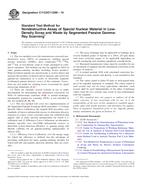 ASTM C1133/C1133M-10..
ASTM C1133/C1133M-10..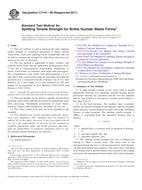 ASTM C1144-89(2011)..
ASTM C1144-89(2011)..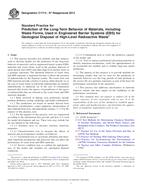 ASTM C1174-07(2013)..
ASTM C1174-07(2013).. ASTM C1207-10
ASTM C1207-10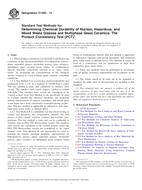 ASTM C1285-14
ASTM C1285-14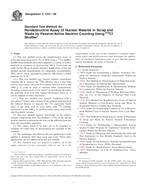 ASTM C1316-08
ASTM C1316-08
 Cookies
Cookies
